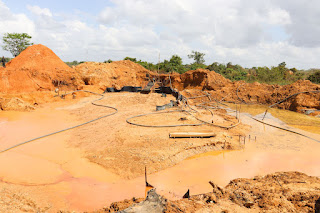Biofuel Meaning, History, Production, Types, Examples
Biofuel is a fuel derived from biomass. This article discusses biofuel meaning, history, production, types an example, as outlined below;
-Biofuel Meaning: 8 Ways to Define A Biofuel
-History and Origin of Biofuel
-The Three (3) Types of Biofuel
Biofuel Meaning: 8 Ways to Define A Biofuel
A biofuel is a fuel which is derived from various types of organic matter, such as plant and aim waste
Given that biofuel is derived primarily from organic sources, it can be defined from a biological and biochemical perspective, as follows;
Biofuel is any fuel which originates from organic materials, through a combination of biological and biochemical processes that produce and/or transform the organic materials to form energy sources.
With regards to the biological and biochemical processes involved in producing biofuel, links to other important concepts like waste-to-energy and biomass conversion, can be highlighted. These related concepts are given consideration in the following biofuel meaning;
Biofuel is a fuel which can be derived in the process of waste-to-energy conversion of organic matter, which may occur in the form of trans-esterification, anaerobic digestion and pyrolysis, among other methods.
One of the important discussions in relation to biofuel is sustainability [17]. Aspects of sustainability that are covered include energy conservation, economic growth, renewable technology, and ecosystem protection. The sustainability perspective is portrayed in the following definition;
A biofuel is an energy source produced from organic matter, whose production and consumption are in line with efforts to achieve sustainability through the conservation of environmental resources.
While the use of biofuel is not currently a major aspect of renewable energy development, it can be described as a prospective factor in the field of renewable energy. The biofuel meaning within the context of renewable energy development is given below;
Biofuel is a source of bio-energy; a type of renewable energy that is derived from plant and animal organic matter through a combination of energy-extraction processes.
There are a number of uses that are assigned to biofuel. Some of these uses are mentioned in the following definition;
Biofuel is a fuel produced from renewable sources like plant and animal matter, and which is used in electricity generation and automotive power supply, among other applications [3].
To provide a more elaborate view of the concept, biofuel can be defined with a brief outline of some sources, examples and physical characteristics, as follows;
A biofuel is a fuel occurring in solid, gaseous or liquid form, derived from organic sources like algae, vegetables, animal fat, sugary crops and animal waste, and examples of which include wood, ethanol, biogas (methane), and biodiesel.
Lastly, biofuel can be defined in terms of its economic relevance, especially as an alternative to fossil fuels;
Biofuel is a fuel produced from organic materials, which presents prospects of transitioning to a green and sustainable economy by replacing fossil fuels like coal and petroleum, thereby reducing the risk of environmental degradation and its associated socioeconomic problems.
History and Origin of Biofuel
The origin of biofuel usage dates back to prehistoric times. Ancient mythology includes accounts of the early discovery and utilization of firewood, by Homo Erectus [5].
Some of these prehistoric accounts also point to the production of charcoal, a biofuel derived from plant biomass by the process of pyrolysis. Evidence of the early use of charcoal can.be found in cave markings among other archeological pieces of evidence.
Discovery of fossil fuels occurred after the discovery of wood biofuel and charcoal. Some prehistoric records describe the similarity between natural coal and charcoal derived from wood.
Accounts dating back to 4000 B.C describe the early use of liquid biofuel in the form of oils and alcohols derived from plant and animal matter [16]. The primary use of liquid biofuel at its early stages was lighting.
One of the important developments in the course of biofuel discovery was the usefulness of organic matter and its conversion-byproducts, in soil conservation.
Charcoal and biochar (a byproduct of the pyrolysis of solid biofuel) were identified as soil amendments (or additives) around 400 B.C [13].
In the following centuries, various studies were conducted to assess the potential of these materials as organic fertilizers. The use of such organic additives had become an important aspect of soil conservation, and an integral part of some agricultural practices like crop rotation.
Steam-production with energy from biofuel, commenced in the form of primitive water-heating systems around A.D 50 [8]. While the early method is much different from modern steam-engine technology, it served as a practical precursor, based on which modern designs were developed.
Industrial biomass conversion commenced after the year 1100, when ethanol was produced from organic matter through fermentation (an aspect of anaerobic digestion). Although the practice of brewery already involved alcohols before this time, there were no clearly established and widely accepted principles regarding the methods and potential used of the liquid biofuel.
Gaseous biofuel became a topic of analysis after Belgian chemist Jan Baptiste van Helmont observed and evaluated the flammable characteristics of biogas in 1630 [4]. His observation provided insight into the role of biodegradation in the natural production of this biofuel.
Whale oil may be considered an example of liquid biofuel. Its discovery dates back to the sixteenth century, during which this resource became an important commercial commodity [14]. As at 1720, whale oil was one of the major fuels sold and used for lighting. Aside lighting, it also found application in the manufacturing industry.
Between the seventeenth and eighteenth centuries, important research was conducted by scientists like Arthur Bushwell and Humphrey Davey, to analyze the properties and origin of biofuel from organic matter and biochemical processes.
These studies were crucial to the decision-making for energy sources to be used in newly-developed technologies during the industrial era. They also provided more information regarding the sustainability of biofuel and its compatibility with the ecosystem.
As part of improvements to existing conversion techniques, biomass gasification was introduced in a patent by English inventor John Barber in 1791 [15]. This was as part of inventions in steam turbine technology.
More elaborate findings in relation to biofuel production by gasification of biomass, were made by Philippe Lebon D’Humbersin and Karl Gustav Bischof in 1801 and 1835 respectively. These findings revolved around the techniques, conditions and equipment for biomass gasification.
Torrefaction of biomass was proposed as an alternative to pyrolysis in 1835, by Adéodat Dufournel.
Biodiesel; a liquid biofuel, was popularized through discoveries by Freidrich Rochieder and Patrick J. Duffy in 1846 and 1853 respectively [12]. The method of production of this fuel which was discovered in these studies was trans-esterification.
In 1861, Louis Pasteur discovered butanol; a biofuel produced through fermentation [11]. Building upon this discovery, the role of various microorganisms in biomass conversion and biofuel production was studied in subsequent years.
Rudolf Diesel is credited with the invention of the diesel engine in the 1890s [1]. One model of this engine which was exhibited in 1900, ran on liquid biofuel.
Ethanol production was commercialized in 1900, based on the Classen Process introduced by Alexander Classen. The main raw material used as feedstock in this process was wood.
Based on earlier studies on the industrial use of liquid biofuel by Samuel Moray [18], the early twentieth century saw the proliferation of ethanol-driven engines. During this time, assessments were made to develop an optimal blend ratio between ethanol and other fuel components for these engines.
Other feedstock options like corn and sugar cane were also introduced into the ethanol-production industry.
The production of cellulosic ethanol from sulfite liquor was commercially introduced in Switzerland, Sweden and North America between 1909 and 1945. Franz Schardinger observed the production of another biofuel; acetone, through fermentation, in 1905 [7].
Friedrich Bergius introduced a method of regulating the physicochemical conditions of biomass hydrogenation to include high temperature and high pressure in 1911.
In the 1930s, there was a rise in interest with regards to processes for the production of more efficient liquid biofuel. Efforts in this direction includes measured to refine vegetable oils in order to yield a flammable product. Liquid biofuel also saw a brief rise to prominence in the during the second world war in the1940s.
Pyrofuel was discovered in the 1970s, as a product of fast pyrolysis of organic solid waste.
The period from the 1970s to the early twenty-first century has generally seen modifications to the methods and equipment used in production and utilization of biofuel.
How Biofuel is Produced
Biofuel is made from renewable organic materials like plant, animal and microbial matter, through natural or physicochemical conversion processes such as photosynthesis, fermentation, pyrolysis and anaerobic digestion.
Photosynthesis and nutrition are natural processes by which wood biofuel is made, while fermentation, pyrolysis and anaerobic digestion are conversion processes that alter the properties of organic matter to produce biogas, biodiesel, butanol. ethanol and methanol.
The Three (3) Types of Biofuel
The three (3) types of biofuel are solid. liquid and gaseous biofuel.
It is important to note that the types of biofuel are categorized based on physical properties, and each type has a number of individual examples.
-Types of Biofuel: Solid
Solid biofuel is any organic matter which occurred in the solid state and can serve as an energy source. This type of biofuel is the earliest-used. and one of the most common. It does not require any conversion process before it can be utilized.
An example of solid biofuel is wood, which can be derived from plants.
The use of solid biofuel is most prominent in domestic scenarios. While it is relatively cheap, renewable and easy to use, the combustion of solid biofuel is associated with environmental problems like greenhouse gas emission, decline in air quality, and global warming [2].
-Types of Biofuel: Liquid
Liquid biofuel is any derivative of biomass conversion process, which occurs in the liquid state and can serve as a source of renewable energy.
Ethanol is the most common liquid biofuel, derived from anaerobic breakdown of various forms of organic matter. Recent developments in the field of bio-energy include efforts to utilize liquid biofuel in electric generators and automotive systems.
-Types of Biofuel: Gaseous
Gaseous biofuel refers to any gaseous product of biochemical processes involving organic matter.
Microbial decomposition is an example of such biochemical processes that produce gaseous biofuel. This process may occur naturally, or through controlled methods like anaerobic digestion and pyrolysis.
Gaseous biofuel is a major commercialized source of renewable energy. Biofuel plants produce these gases during waste-to-energy projects, to be used for electricity generation and other purposes.

Examples of Biofuel
Six (6) examples of biofuels are; biogas, biodiesel, wood, ethanol, butanol and methanol.
1). Biogas as one of the Examples of Biofuels
Biogas is a gaseous biofuel which is composed of 50-75% methane, 25-50% carbon dioxide, 2-8% nitrogen, and trace amounts of other gases [9].
The primary combustible component of biogas is methane, while other trace components include hydrogen, volatile organic compounds and ammonia.
Biogas is a product of processes like anaerobic digestion, natural biodegradation and pyrolysis. It is one of the most efficient examples of biofuel.
2). Wood as one of the Examples of Biofuels
Wood is arguably the most basic and common form of biofuel.
Also referred to as woody biomass, it can be derived from plants, and occurs in various forms such as sawdust, forest residue, wood chips, pellets and firewood. It may also undergo physicochemical conversion to form products like biochar and charcoal, which can be used as soil amendment.
The uses of wood as a biofuel range from domestic heating to processed and steam turbine energy supply.

3). Ethanol
Ethanol is a liquid biofuel which can be derived from the anaerobic conversion of plant and animal biomass [6].
It is a member of the hydrocarbon family called alcohols, and has some physicochemical properties that make it useful as an energy source. Some developments in biofuel technology include the use of ethanol as a component of automobile energy supply materials.
4). Butanol as one of the Examples of Biofuels
Butanol is derived from the fermentation or anaerobic breakdown of starchy organic matter. It is also a member of the alcohol hydrocarbon family and bears physicochemical similarities to ethanol.
While butanol is a potentially-useful fuel, its use is limited by the difficulty of its production.
5). Methanol as one of the Examples of Biofuels
Another biofuel from the alcohol hydrocarbon family is methanol.
It is a green energy source which is used in the automobile industry. The production of methanol from biomass is usually achieved through catalytic gasification [10].
6). Biodiesel
Biodiesel is a liquid biofuel produced from mostly plant biomass, although animal matter is also useable.
The conversion process by which biodiesel is produced is called trans-esterification; and involves the chemical reaction between esters and alcohols. Biodiesel is chemically composed of long-chain structures made from fatty acid esters.
Conclusion
Biofuel is any solid, liquid or gaseous material that is produced from organic sources and processes. The biofuel meaning can be given based on a various factors with regards to the origin and relevance of these substances.
Types of biofuel are
- Solid
- Liquid
- Gaseous
Examples of biofuel are;
- Biogas
- Wood
- Ethanol
- Butanol
- Methanol
- Biodiesel
References
1). Agarwal, A. K.; Dhar, A. (2010). “Experimental Investigations of Engine Durability and Lubricating Oil Properties of Jatropha Oil Blends Fuelled DI Diesel Engine.” Available at: https://doi.org/10.1115/ICEF2009-14116. (Accessed 3 June 2022).
2). Bailis, R.; Pennise, D.; Ezzati, M.; Kammen, D. M.; Kituyi, E. (2004). “IMPACTS OF GREENHOUSE GAS AND PARTICULATE EMISSIONS FROM WOODFUEL PRODUCTION AND END-USE IN SUB-SAHARAN AFRICA.” Available at: https://www.researchgate.net/publication/237236947_IMPACTS_OF_GREENHOUSE_GAS_AND_PARTICULATE_EMISSIONS_FROM_WOODFUEL_PRODUCTION_AND_END-USE_IN_SUB-SAHARAN_AFRICA. (Accessed 3 June 2022).
3). Börjesson, M.; Ahlgren, E. O.; Lundmark, R.; Athanassiadis, D. (2014). “Biofuel futures in road transport – A modeling analysis for Sweden.” Transportation Research Part D Transport and Environment 32:239–252. Available at: https://doi.org/10.1016/j.trd.2014.08.002. (Accessed 3 June 2022).
4). Chasnyk, O.; Solowski, G.; Shkarupa, O. (2015). “Historical, technical and economic aspects of biogas development: Case of Poland and Ukraine.” Renewable and Sustainable Energy Reviews 52:227-239. Available at: https://doi.org/10.1016/j.rser.2015.07.122. (Accessed 3 May 2022).
5). Gowlett, J. A. J. (2016). “The discovery of fire by humans: A long and convoluted process.” Philosophical Transactions of The Royal Society B Biological Sciences 371(20150164). Available at: https://doi.org/10.1098/rstb.2015.0164. (Accessed 3 June 2022).
6). Guruviah, K.; Sivasankaran, C.; Jayamuthunagai, J.; Bharathiraja, B.; Ramanujam, P. K. (2019). “Conversion of Biomass to Methanol and Ethanol.” Horizons in Bioprocess Engineering (pp.61-72). Available at: https://doi.org/10.1007/978-3-030-29069-6_4. (Accessed 3 June 2022).
7). Karstens, K.; Trippel, S.; Götz, P. (2021). “Process Engineering of the Acetone-Ethanol-Butanol (ABE) Fermentation in a Linear and Feedback Loop Cascade of Continuous Stirred Tank Reactors: Experiments, Modeling and Optimization.” Available at: https://doi.org/10.3390/fuels2020007. (Accessed 3 May 2022).
8). Lane, J. (2016). “Where did biofuels technologies come from?” Available at: https://www.biofuelsdigest.com/bdigest/2016/06/01/where-did-biofuels-technologies-come-from/. (Accessed 3 June 2022).
9). Li, Y.; Alaimo, C. P.; Kim, M.; Kado, N. Y.; Peppers, J.; Xue, J.; Wan, C.; Green, P. G.; Zhang, R.; Jenkins, B. M.; Vogel, C.; Wuertz, C.; Young, T. M.; Kleeman, M. J. (2019). “Composition and Toxicity of Biogas Produced from Different Feedstocks in California.” Environmental Science and Technology 53(19). Available at: https://doi.org/10.1021/acs.est.9b03003. (Accessed 2 June 2022).
10). Mphoswa, R. (2015). “Methanol Production from Biomass.” Chemical Process Design. Available at: https://www.researchgate.net/publication/284411944_Methanol_Production_from_Biomass. (Accessed 3 June 2022).
11). Ndaba, B.; Chiyanzu, I.; Marx, I. (2015). “N-Butanol derived from biochemical and chemical routes: A review.” Biotechnology Reports 8(C). Available at: https://doi.org/10.1016/j.btre.2015.08.001. (Accessed 3 June 2022)..
12). Patrick, D. (1853). “XXV. On the constitution of stearine”. Quarterly Journal of the Chemical Society of London. 5 (4): 303. Available at: https://doi.org/10.1039/QJ8530500303. (Accessed 3 June 2022).
13). Ryan, K. (2013). “Biochar: a brief history and developing future.” Available at: https://news.mongabay.com/2013/01/biochar-a-brief-history-and-developing-future/. (Accessed 3 June 2022).
14). Schokkenbroek, J. (2008). “Trying-Out: An Anatomy of Dutch Whaling and Sealing in the Nineteenth Century, 1815-1885: A Roundtable Response.” International Journal of Maritime History 20(2):357-359. Available at: https://doi.org/10.1177/084387140802000217. (Accessed 3 May 2022).
15). Sikarwar, V.; Zhao, M.; Clough, P.; Yao, J. G.; Zhong, X.; Memon, M. Z. H.; Shah, N.; Anthony, E.; Fennell, P. (2016). “An overview of advances in biomass gasification.” Energy & Environmental Science 9(10):2927–3304. Available at: https://doi.org/10.1039/C6EE00935B. (Accessed 3 June 2022).
16). Singh, R. S.; Walia. A. (2017). “Biofuels Historical Perspectives and Public opinions.” Biofuels: Production and Future Perspectives (pp.3-23), CRC Press, Taylor & Francis Group, Boca Raton, London. Available at: https://www.researchgate.net/publication/311575858_Biofuels_Historical_Perspectives_and_Public_opinions. (Accessed 3 June 2022).
17). Solomon, B. (2010). “Biofuels and sustainability.” Annals of the New York Academy of Sciences 1185(1):119-34. Available at: https://doi.org/10.1111/j.1749-6632.2009.05279.x. (Accessed 2 June 2022).
18). Songstad, D.; Lakshmanan, P.; Chen, J.; Gibbons, W. R. (2010). “Historical Perspective of Biofuels: Learning from the Past to Rediscover the Future.” In Vitro Cellular & Developmental Biology – Plant 45(3):1-7. Available at: https://doi.org/10.1007/978-1-4419-7145-6_1. (Accessed 3 May 2022).




